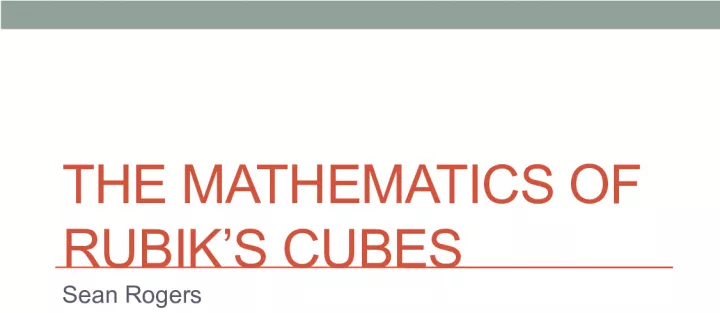The Mathematics of Rubik's Cubes: Modeling and Functions


With over 43 quintillion possible states, the Rubik's Cube poses a challenge for mathematicians. Models are created using sets and functions, such as L, R, U, B, D, R2, and more, which are bijections from one set to another.
- Uploaded on | 0 Views
-
 nishitha
nishitha
About The Mathematics of Rubik's Cubes: Modeling and Functions
PowerPoint presentation about 'The Mathematics of Rubik's Cubes: Modeling and Functions'. This presentation describes the topic on With over 43 quintillion possible states, the Rubik's Cube poses a challenge for mathematicians. Models are created using sets and functions, such as L, R, U, B, D, R2, and more, which are bijections from one set to another.. The key topics included in this slideshow are . Download this presentation absolutely free.
Presentation Transcript
1. THE MATHEMATICS OF RUBIK’S CUBES Sean Rogers
2. Possibilities • 43,252,003,274,489,856,000 possible states • Depends on properties of each face • That’s a lot!! • Model each as a set • Define R _0 as the solved state • {r_1, r_2, r_4 …, r_9, b_1, b_2, b_3 … b_9, w_1 …} • So every set has 54 elements
3. Functions • Define f: R _x R _y as this: • We have a special name for this: L • Similarly, we have R, U, B, D, R^2, L’, R’, etc. • These functions are bijections from one set to another • Obvious- one-to-one correspondence, |R_ x |=|R_ y|
4. How to get from A to B R _7 R _6 R _5 R _4 R _3 R _2 R _1 R _0
5. Algorithms • We collect these bijections into algorithms (macros) to get from one set to another (when you know the properties of the 2 sets required)
6. Groups
7. Examples
8. To Rubik’s Cubes • Our group will be R, all possible permutations of the solved state (remember there are ~43 quintillion) • * will be a rotation of a face (associative so long as order is preserved) • Inverse is going the opposite direction
9. Cycles and Notation • Cycle- permutation of the elements of some set X which maps the elements of some subset S set to each other in a cyclic manner, while fixing all other elements (mapping them to themselves) • (1)(2 3 4) • 1 stays put, 2, 3, and 4 are cycled in some manner • Ex. {1,2,3,4} {3,4,1,2} is a cycle • You can’t just switch 2 blocks- permutations are products of 2-cycles • Ex. (1 2 3)=(1 2)(1 3) • Analogue- Prime factorizations
11. Conjugacy
12. The Cube • Several methods to solve • They make even bigger, harder cubes • You don’t need this math though- its just a rigorous way of defining a puzzle • Invented in 1974 by Ernő Rubik